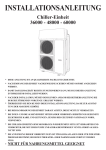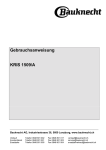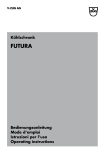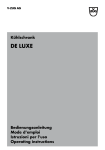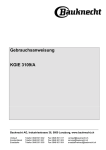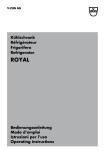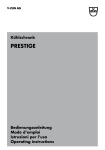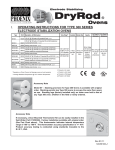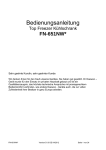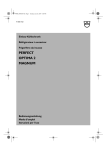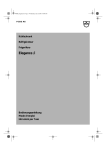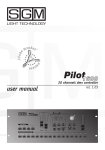Download Télécharger la fiche technique produits - V-Zug
Transcript
V-ZUG AG Einbau-Kühlschrank Réfrigérateur à encastrer Frigorifero da incasso Built-in refrigerator Prima 60i Bedienungsanleitung Mode d’emploi Istruzioni per l’uso Instruction for use Liebe V-ZUG-Kundin, lieber V-ZUG-Kunde Wir danken Ihnen, dass Sie sich für den Kauf eines unserer Produkte entschieden haben. Ihr Gerät genügt hohen Ansprüchen und seine Bedienung ist einfach. Nehmen Sie sich trotzdem Zeit, diese Bedienungsanleitung zu lesen. So werden Sie mit Ihrem Gerät vertraut und können es optimal und störungsfrei benutzen. Text, Bild und Daten entsprechen dem technischen Stand des Gerätes zur Zeit der Drucklegung dieser Bedienungsanleitung. Änderungen im Sinne der Weiterentwicklung bleiben vorbehalten. Beachten Sie bitte die Sicherheitshinweise. Gültigkeitsbereich Die vorliegende Bedienungsanleitung gilt für folgendes Modell Typ Modell-Nr. Masssystem KPA60i 51065 EURO 60 Die Modellnummer entspricht den ersten 3 Ziffern auf dem Typenschild Chère cliente, cher client V-ZUG Nous vous remercions d’avoir porté votre choix sur l’un de nos produits. Votre nouvel appareil répond aux exigences les plus élevées et son utilisation est des plus simples. Accordez-vous le temps nécessaire pour lire attentivement ce mode d’emploi. Vous vous familiariserez ainsi avec votre appareil, ce qui vous permettra de l’utiliser de manière optimale et sans dérangement. Le texte, les illustrations et les données correspondent au niveau technique de l’appareil au moment de la mise sous presse de ce mode d’emploi. Sous réserve de modifications dans le cadre du progrès technique. Veuillez tenir compte des conseils de sécurité. Domaine de validité Le présent mode d’emploi est valable pour les modèles suivants Type No de modèle Système de mesure KPA60i 51065 EURO 60 Le numéro de modèle correspond aux 3 premiers chiffres figurant sur la plaque signalétique Cara cliente V-ZUG, caro cliente V-ZUG Vi ringraziamo per aver scelto uno dei nostri prodotti. Il vostro apparecchio soddisfa elevate esigenze, e il suo uso è molto semplice. E’ tuttavia necessario che vi prendiate il tempo per leggere queste istruzioni per l’uso che vi permetteranno di comprendere meglio l’apparecchio e di utilizzarlo in modo ottimale e senza problemi. Testo, immagine e dati corrispondono al livello tecnico dell’apparecchio al momento della stampa di queste istruzioni per l’uso, con riserva di modifiche intese come ulteriore sviluppo. Vi preghiamo di attenervi alle osservazioni sulla sicurezza. Campo di validità Queste istruzioni per l’uso riguardano i seguenti modelli Tipo Modello n°. Sistema di misura KPA60i 51065 EURO 60 Il numero del modello corrisponde alle prime 3 cifre sulla targhetta dei dati Dear customer V-ZUG Thank you for choosing one of our products. Your appliance meets high requirements and it is very easy to use. However, spend enough time on reading these operating instructions that will allow you to better understand the appliance and use it in an optimal manner and without problems. Text, image and data refer to the technical level of the appliance at the time of printing these operating instructions, which are subject to changes for further development. Please comply with safety remarks. Validity range These operating instructions refer to the following models Type Model n°. Measurement system KPA60i 51065 EURO 60 Model number can be identified by the first 3 digits on the data plate © V-ZUG AG, CH-6301 Zug DEUTSCH FRANçAIS ITALIANO ENGLISH Bedienungsanleitung Mode d'emploi Istruzioni per l'uso lnstruction for use Seite 4 Page 8 Pagina 12 Page 16 ERSTMALIGER GEBRAUCH Schliessen Sie das Geräte am Strom an. Die idealen Aufbewahrungstemperaturen der Lebensmittel wurden bereits im Werk voreingestellt (3-4/MED). Anmerkung: Nach dem Inbetriebsetzen müssen 2 bis 3 Stunden vergehen bis die Aufbewahrungstemperatur erreicht ist und Produkte normal gelagert werden können. REINIGUNG UND WARTUNG Das Gerät periodisch reinigen. Verwenden Sie dazu ein Tuch, lauwarmes Wasser und ein geeignetes neutrales Reinigungsmittel für das Kühlschrankinnere. Verwenden Sie nie andere Reinigungsmittel oder Scheuermittel. Damit das Tauwasser richtig abfließen kann, das Drainageloch für das Tauwasser, an der Rückseite in der Nähe des Obstund Gemüsefachs, regelmäßig mit dem mitgelieferten Werkzeug reinigen (siehe Abbildung). Vor Reinigungs- oder Instandhaltungsarbeiten ist die Stromversorgung durch Abziehen des Steckers oder Ausschalten des Geräts zu unterbrechen. LÄNGERER STILLSTAND DES GERÄTS Trennen Sie das Gerät von der Stromversorgung, leeren Sie es, lassen Sie es auftauen und reinigen Sie es. Lassen Sie die Türen des Geräts etwas geöffnet damit die Luft im Inneren der Räume zirkulieren kann. Dadurch vermeiden Sie Schimmelbildung und schlechte Gerüche. STROMAUSFALL Tür des Geräts geschlossen halten. So bleibt die niedrige Lebensmitteltemperatur länger erhalten. Teilweise aufgetaute Lebensmittel nicht wieder einfrieren sondern innerhalb von 24 Stunden verbrauchen. BETRIEBSWEISE DES KÜHL- UND GEFRIERRAUMS Temperatureinstellung: • Informationen zur Temperatureinstellung siehe beigefügtes Produkt-Datenblatt. Hinweis: Die Umgebungstemperatur, die Häufigkeit der Türöffnung, das Einstellen von heißen Lebensmitteln und eine ungeeignete Geräteposition können die Innentemperatur des Geräts beeinflussen, welche von der auf dem Display angezeigten Temperatur abweichen kann. 4 KÜHLRAUM Das Abtauen des Kühlraums erfolgt vollautomatisch. Die periodische Bildung von kleinen Wassertropfen an der Innenwand hinter den Schubfächern, ist die Folge des automatischen Abtauvorgangs. Das Tauwasser wird automatisch in eine Abflussöffnung geleitet und anschließend in einem Behälter gesammelt, in dem es verdunstet. Gebläse (falls vorhanden) Das Gebläse funktioniert automatisch. Durch das Gebläse wird die Temperatur im Inneren des Kühlraums besser verteilt, was der besseren Lebensmittelaufbewahrung beiträgt und die Luftfeuchtigkeit verringert. Die Ansaugöffnung nicht verstopfen. Das Gebläse schaltet nur ein, wenn der Motor in Betrieb ist. Achtung: das Kühlschrankzubehör darf nicht im Geschirrspüler gereinigt werden. GEFRIERRAUM Dieses Gerät ist ein Sternen-Kühlschrank mit Gefrierraum. Tiefgefrorene Lebensmittel können für die auf der Packung angegebene Zeit aufbewahrt und frische Lebensmittel können eingefroren werden, wobei sie jedoch schon eingefrorene Lebensmittel nicht berühren sollten. Die Menge frischer Lebensmittel, die innerhalb von 24 Stunden eingefroren werden kann, ist auf dem Typenschild angegeben. Teilweise aufgetaute Lebensmittel sollten nicht wieder eingefroren sondern innerhalb von 24 Stunden verbraucht werden. Weitere Informationen zum Einfrieren frischer Lebensmittel, entnehmen Sie bitte der Kurzanleitung. Schubfächer herausnehmen (je nach Modell) Die Schubfächer bis zum Anschlag ausziehen, leicht anheben und herausnehmen. Anmerkung: Der Gefrierraum kann auch ohne Schubfächer verwendet werden, wenn mehr Stauraum erforderlich ist. Für den einwandfreien Betrieb des Gefrierraums, darf das untere Schubfach nicht entfernt werden. Kontrollieren Sie ob die Tür des Gefrierraums auch nach Einlegen des Gefrierguts richtig schließt. Herstellen von Eiswürfeln (falls vorhanden) Den entsprechenden Behälter zu 2/3 mit Wasser füllen und in den Gefrierraum stellen. Verwenden Sie auf keinen Fall spitze oder scharfe Gegenstände, um die Schale herauszunehmen. GEFRIERRAUM AUFTAUEN Wir empfehlen den Gefrierraum 1 oder 2 Mal pro Jahr oder dann abzutauen, wenn sich zu viel Reif angesammelt hat (3 mm dick). Die Reifbildung ist eine normale Erscheinung. Wie viel und wie schnell sich Reif ansammelt ist von den Umgebungsbedingungen und der Häufigkeit mit der die Tür geöffnet wird abhängig. Um den Gefrierraum aufzutauen, je nach Modell diesen oder das ganze Gerät ausschalten und alle Lebensmittel herausnehmen. Lassen Sie die Gefrierraumtür geöffnet, damit der Reif abtauen kann. Nur bei den Geräten wie in Abb. 2, den Ablaufkanal des Tauwassers herausnehmen und eine Schale unter den Ablass stellen. Nach beendetem Vorgang den Ablaufkanal wieder montieren. Das Gefrierrauminnere reinigen. Nachspülen und sorgfältig abtrocknen. Den Gefrierraum oder das ganze Gerät wieder einschalten und die Lebensmittel wieder einlegen. 5 AUFBEWAHREN DER LEBENSMITTEL Die einzufrierenden Lebensmittel so einwickeln, dass weder Wasser noch Feuchtigkeit oder Kondensat eindringen können; Dadurch wird die Übertragung von Gerüchen oder Aromen vermieden und eine bessere Konservierung des Gefriergutes gewährleistet. Niemals warme Lebensmittel in den Gefrierraum stellen. Lebensmittel vor dem Einfrieren abkühlen lassen, heißt Energie sparen und die Lebensdauer des Geräts verlängern. STÖRUNGEN - WAS TUN? 1. Wenn das Gerät nicht funktioniert. • Liegt ein Stromausfall vor? • Ist der Netzstecker richtig angeschlossen? • Ist der Zweipolschalter eingeschaltet? • Ist die Sicherung durchgebrannt? • Ist das Stromkabel beschädigt? • Ist der Thermostat auf • gedreht (Stop)? 5. Wenn die Innenbeleuchtung nicht funktioniert. Kontrollieren Sie zuerst Punkt 1, und dann: • Ziehen Sie den Netzstecker aus der Steckdose. Um die Glühbirne auszuwechseln, siehe Kapitel „Betrieb des Kühl- und Gefrierraums“. • Glühbirne kontrollieren und wenn nötig, mit einer neuen ersetzen (siehe Angaben in der Nähe der Glühbirne). 2. • • • • Die Innentemperatur des Kühl- und Gefrierraums ist nicht kühl genug. Schließen die Türen richtig? Ist das Gerät in der Nähe einer Wärmequelle aufgestellt worden? st der Thermostat auf der richtigen Position? Wird die Luftzirkulation durch verstopfte Belüftungsschlitze behindert? 6. Die rote Kontrollleuchte am Bedienfeld des Gefrierraums leuchtet ständig / der akustisch Alarm ist aktiv. (je nach Modell) • Es wurde vor kurzem eine große Menge an frischen Lebensmitteln in den Gefrierraum gelegt. • Die Gefrierraumtür schließt nicht richtig (siehe auch Anweisungen in der Kurzanleitung) 3. Die Innentemperatur des Kühlraums ist zu kalt. • Ist der Thermostat auf der richtigen Position? 4. Wasser steht auf dem Boden des Kühlraums. • Ist der Tauwasserabfluss verstopft? (siehe Abschnitt Reinigung und Wartung). Anmerkungen: • Der vordere Rand des Kühlschranks kann warm werden, um Reifbildungen zu vermeiden; das ist normal. • Wasser- und Luftgeräusche aus dem Kühlmittelkreislauf sind normal. 6 REPARATUR-SERVICE Wenn Sie aufgrund einer Betriebsstörung oder einer Bestellung mit uns Kontakt aufnehmen, nennen Sie uns stets die Fabrikations-Nummer (FN) und die Bezeichnung Ihres Gerätes. Tragen Sie diese Angaben hier ein und auch auf dem mit dem Gerät gelieferten Service-Kleber (kleben Sie diesen an einer gut ersichtlichen Stelle oder in Ihrer Telefon- Agenda ein). Gerät FN Um unnötige Fehlermeldungen zu vermeiden, prüfen Sie bitte vor der Anforderung eines Servicemonteurs, ob die Stromversorgung gewährleistet ist (Ist der Stecker eingesteckt? Ist die Sicherung intakt?). Anfragen, Bestellungen, Servicevertrag Bei Anfragen und Problemen administrativer und technischer Art sowie für die Bestellung von Ersatzteilen und Zubehör wenden Sie sich bitte direkt an den Hauptsitz in Zug, Tel. 041/767 67 67. - Diese Angaben finden Sie auf dem Garantieschein oder der Ori- ginal-Rechnung, bzw. auf dem Typenschild Ihres Gerätes. Das Typenschild befindet sich links neben der linken Gemüseschale. Für den Unterhalt aller unserer Produkte haben Sie die Möglichkeit, im Anschluss an das Garantiejahr einen Servicevertrag abzuschliessen. Wir senden Ihnen gerne die entsprechenden Unterlagen Bei Betriebsstörungen erreichen Sie unter Gratis- Telefonnummer 0800 850 850 das nächste Service-Center der V-ZUG AG INSTALLATION Elektrischer Anschluss • Die elektrischen Anschlüsse müssen unter Einhaltung der örtlichen Vorschriften erfolgen. • Die Daten der Spannung und der Stromaufnahme sind auf dem Typenschild im Inneren des Geräts angegeben. • Die Erdung des Geräts ist gesetzlich vorgeschrieben. Der Hersteller haftet nicht für Verletzungen von Personen oder Tieren und für Schäden durch Missachten der oben genannten Vorschriften. • Falls der Stecker nicht in die Steckdose passen sollte, lassen Sie ihn von einem qualifizierten Fachmann ersetzen. • Weder Einzel- noch Mehrfachadapter oder Verlängerungskabel verwenden. • Installieren Sie das Gerät fern von Wärmequellen. Die Installation in einem warmen Raum, die direkte Sonnenbestrahlung oder die Aufstellung in der Nähe einer Wärmequelle (Heizkörper, Herd) erhöhen den Stromverbrauch und sollten vermieden werden. • Falls dies nicht möglich sein sollte, beachten Sie bitte folgende Mindestabstände: - 30 cm fern von Kohlen- und Ölherden; - 3 cm fern von elektrischen und/oder Gasherden. • Die Distanzstücke (wenn mitgeliefert) an die Rückseite des Kondensators hinter dem Gerät montieren. • An einem trockenen und gut belüfteten Ort, aufstellen und, falls erforderlich, über die Vorderfüße nivellieren. • Reinigen Sie das Geräteinnere. • Setzen Sie das mitgelieferte Zubehör ein. Gerät vom Stromnetz abtrennen Das Gerät muss vom Stromnetz abgetrennt werden können entweder durch abziehen des Steckers oder über einen zweipoligen Schalter der vor der Steckdose montiert wird. 7 PREMIERE UTILISATION Branchez l’appareil au réseau électrique. Les températures idéales de conservation des aliments sont préréglées en usine (3-5/MED). Remarque: Après la mise en fonction, il est nécessaire d’attente 2/3 heures avant d’atteindre la température de conservation adaptée à un chargement normal du produit. ENTRETIEN ET NETTOYAGE Nettoyez régulièrement l’appareil à l’aide d’un chiffon et d’une solution d’eau tiède et de détergents neutres spécifiques pour le nettoyage de l’intérieur du réfrigérateur. N’utilisez jamais de détergents ou d’abrasifs. Pour garantir l’écoulement constant et correct de l’eau de dégivrage, nettoyez régulièrement l’intérieur de l’orifice de drainage sur la paroi arrière du réfrigérateur à proximité du bac à légumes en utilisant l’ustensile fourni (voir figure). Avant d’effectuer toute opération d’entretien ou de nettoyage, débranchez la fiche de la prise de courant ou couper l’alimentation électrique de l’appareil. EN CAS D’INUTILISATION DE L’APPAREIL Débranchez l’appareil, videz l’appareil, dégrivez-le et nettoyez-le. Tenez les portes de l’appareil légèrement entrebâillées afin de faire circuler l’air à l’intérieur des compartiments. Vous éviterez de cette façon la formation de moisissure et de mauvaises odeurs. EN CAS DE PANNES DE COURANT Tenez fermées les portes de l’appareil. De cette façon les aliments resteront froids le plus longtemps possible. Ne recongelez pas les aliments partiellement décongelés, mais consommez-les dans un délai de 24 heures. FONCTIONNEMENT DU COMPARTIMENT REFRIGERATEUR ET CONGELATEUR Réglage de la température : • Pour des informations sur le réglage de la température, reportez-vous à la fiche technique jointe. Remarque : La température ambiante, la fréquence d’ouverture de la porte, le rangement d’aliments encore chauds et le positionnement inadéquat de l’appareil peuvent influencer la température intérieure de l’appareil, qui pourra ne pas correspondre à la température indiquée sur l’affichage. 8 COMPARTIMENT RÉFRIGÉRATEUR Le dégivrage du compartiment réfrigérateur est entièrement automatique. La présence périodique de gouttelettes d’eau sur la paroi arrière à l’intérieur du compartiment réfrigérateur indique la phase de dégivrage automatique. L’eau du dégivrage est conduite directement dans un trou d’évacuation, puis récoltée dans un récipient où elle s’évapore. Ventilateur (si disponible) Le fonctionnement du ventilateur est automatique. Le ventilateur permet une distribution uniforme des températures à l’intérieur du compartiment réfrigérateur entraînant une meilleure conservation des aliments et une réduction de l’humidité en excès. N’obstruez pas la zone d’aspiration. Le ventilateur est actif uniquement pendant la phase de fonctionnement du moteur. Attention : ne lavez pas les accessoires du réfrigérateur au lave-vaisselle. COMPARTIMENT CONGÉLATEUR Cet appareil possède un compartiment congélateur étoiles. Il est possible de conserver les aliments surgelés pour la durée indiquée sur l’emballage et de congeler les aliments frais en faisant attention à ne pas les mettre en contact avec les aliments déjà congelés. La quantité d’aliments frais qu’il est possible de congeler en 24 heures est indiquée sur la plaque signalétique. Il est conseillé de ne pas recongeler les aliments partiellement décongelés, mais de les consommer dans un délai de 24 heures. Pour plus de renseignements à propos de la congélation des aliments frais, consultez le guide de consultation rapide. Extraction des tiroirs (selon modèle) Tirez les tiroirs vers l’extérieur jusqu’à la butée, soulevez-les légèrement et retirez-les. Remarque: Le compartiment congélateur peut également être utilisé sans les tiroirs supérieurs, afin d’obtenir un volume de rangement plus important. Pour un fonctionnement correct du compartiment congélateur, il est obligatoire de laisser en place le tiroir inférieur. Vérifiez qu’après avoir rangé les aliments sur les grilles, la porte du compartiment congélateur ferme correctement. Production de glaçons (si disponible) Remplissez le bac à glaçons aux 2/3 et placez-le dans le compartiment congélateur. N’utilisez pas d’objets pointus ou tranchants pour le décoller. COMMENT DEGIVRER LE COMPARTIMENT CONGELATEUR Nous conseillons de dégivrer le congélateur 1 ou 2 fois par an ou lorsque la formation de givre est excessive (3 mm d’épaisseur). La formation de givre est un phénomène normal. La quantité et la rapidité d’accumulation diffèrent en fonction des conditions ambiantes et de la fréquence d’ouverture de la porte. Pour le dégivrage, éteignez le compartiment congélateur ou l’appareil entier, en fonction du modèle, et retirez tous les aliments. Laissez la porte du congélateur ouverte pour permettre la fonte du givre. Uniquement pour les appareils comme sur la fig. 2 extraire le tube d’évacuation de l’eau du dégivrage et placer une bassine sous la vidange. Remettez en place le tube d’évacuation une fois l’opération terminée. Nettoyez l’intérieur du congélateur. Rincez et séchez soigneusement. Rallumez le compartiment congélateur ou l’appareil entier et remettez en place les aliments à l’intérieur. 9 COMMENT CONSERVER LES ALIMENTS Il est important d’envelopper les aliments de façon à ce que ni eau ni humidité ni vapeur n’y pénètrent ; cela évite le transfert d’odeurs ou de goûts entre aliments dans le réfrigérateur et permet une meilleure conservation des aliments congelés. N’introduisez jamais d’aliments chauds dans le congélateur. En laissant refroidir les aliments avant de les congeler, vous économisez de l’énergie et vous prolongez la durée de l’appareil. DIAGNOSTIC DES PANNES 1. L’appareil ne fonctionne pas. • Y a-t-il une coupure de courant ? • La fiche est-elle bien enfoncée dans la prise de courant ? • L’interrupteur bipolaire de secteur est-il enclenché ? • Les protections de l’installation électrique de l’habitation fonctionnent-elles correctement ? • Le câble d’alimentation est-il sectionné ? • Le thermostat est-il sur la position • (Stop) ? 5. L’éclairage interne ne fonctionne pas. Contrôlez d’abord le point 1, puis: • Débranchez l’appareil. Pour allumer l’ampoule, voir chapitre « Fonctionnement du compartiment réfrigérateur et congélateur ». • Contrôlez l’ampoule et remplacez-la au besoin par une neuve (voir indications à proximité de l’ampoule). 6. Le voyant rouge sur le bandeau de commande du congélateur reste allumé / signal sonore actif. (selon modèle) • Une grande quantité d’aliments frais a-t-elle été placée récemment dans le congélateur ? • La porte du congélateur est-elle mal fermée ? (consultez également le guide de consultation rapide) 2. • • • • La température à l’intérieur des compartiments n’est pas assez froide. Les portes ferment-elles correctement ? L’appareil est-il installé proche d’une source de chaleur ? Le thermostat est-il sur la bonne position ? La circulation de l’air à travers les grilles d’aération n’est-elle pas obstruée ? Remarques: • Si le bord avant du produit est chaud, il ne s’agit pas d’un défaut, mais d’un effet voulu pour éviter la formation de condensation. • Les bruits de gargouillement et les souffles d’expansion dérivant du circuit réfrigérant sont normaux. 3. La température à l’intérieur du compartiment réfrigérateur est trop froide. • Le thermostat est-il sur la bonne position ? 4. Il y a de l’eau sur le fond du compartiment réfrigérateur. • La goulotte d’évacuation de l’eau de dégivrage n’est-elle pas bouchée ? (voyez « Entretien et nettoyage »). 10 SERVICE APRES-VENTE Si vous devez nous contacter suite à un problème de fonctionnement ou pour passer une commande, veuillez toujours nous indiquer le numéro ed fabrication (FN) et la désignation du modèle de votre appareil. Inscrivez ces indications ci-dessous ainsi que sur l’autocollant de service fourni avec l’appareil (placez cet autocollant à un endroit bien visible ou dans votre répertoire téléphonique). Appareil FN Pour éviter des appels inutiles, veuillez vérifier au préalable si l’alimentation électrique est assurée (la prise est-elle branchée? Le fusible est-il intact?). Questions, commandes contrat d’entretien Pour les questions et les problèmes d’ordre administratif ou technique ainsi que pour les commandes de piéces détachées et d’accessoires, veuillez vous adresser directement à l’établissement principal de Zug, Tél. 041/767 67 67. Pour l’entretien de tous nos appareils, vous avez la possibilité de stupuler un contrat d’entretien au terme de l’année de garantie. Sur demande, nous vous ferons parvenir avec plaisir les documents correspondants. - Ces indications figurent sur le certificat de garantie ou sur la facture originale ou encore sur la plaquette signalétique de votre appareil. Cette plaquette signalétique se trouve sur la guache, à cote du bac à légumes. En cas de problèmes de fonctionnement, veuillez contacter le centre de service de V-ZUG SA le plus proche au numéro de téléphone suivant : 0800 850 850 (appel gratuit). INSTALLATION Branchement électrique • Les branchements électriques doivent être réalisés conformément aux réglementations locales en vigueur. • Les données relatives à la tension et à la puissance absorbée sont indiquées sur la plaque signalétique, placée à l’intérieur de l’appareil. • La mise à la terre de l’appareil est obligatoire aux termes de la loi. Le fabricant décline toute responsabilité en cas de blessure causée à des personnes, des animaux domestiques ou en cas de dommage matériel résultant du nonrespect de ces exigences. • Si la fiche et la prise ne sont pas du même type, faites remplacer la prise par un technicien qualifié. • N’utilisez aucune rallonge ou prise multiple. • Installez l’appareil loin des sources de chaleur. L’installation dans un lieux chaud, l’exposition directe aux rayons du soleil ou le placement de l’appareil à proximité d’une source de chaleur (radiateurs, cuisinière) augmentent la consommation d’énergie et doivent être évités. • Si cela n’est pas possible, il est nécessaire de respecter les distances minimum suivantes - 30 cm des cuisinières à charbon ou pétrole ; - 3 cm des cuisinières électriques et/ou à gaz. • Monter les entretoises (si elle sont fournies) sur la partie arrière du condensateur placé derrière l’appareil. • Le positionner à plat (réglez les pieds avant si nécessaire) dans un lieu sec et bien ventilé. • Nettoyez l’intérieur. • Introduisez les accessoires fournis. Débranchement électrique Le débranchement électrique doit être possible soit en débranchant la fiche, soit par l’intermédiaire d’un interrupteur bipolaire de secteur placé en amont de la prise. 11 PRIMO UTILIZZO Collegare l’apparecchio alla rete elettrica. Le temperature per l’ideale conservazione degli alimenti sono già preimpostate in fabbrica (3-5/MED). Nota: Dopo la messa in funzione è necessario attendere circa 2/3 ore prima che venga raggiunta la temperatura di conservazione adeguata ad un normale carico del prodotto. MANUTENZIONE E PULIZIA Pulire periodicamente l’apparecchio utilizzando un panno ed una soluzione di acqua tiepida e detergenti neutri specifici per la pulizia interna del frigorifero. Non usare mai detergenti o abrasivi. Per garantire il deflusso costante e corretto dell’acqua di sbrinamento, pulire regolarmente l’interno del foro di drenaggio situato sulla parete posteriore del frigorifero in prossimità del cassetto frutta e verdura, usando l’utensile in dotazione (vedi figura). Prima di eseguire qualsiasi operazione di manutenzione o pulizia, disinserire la spina dalla presa di corrente o scollegare l’apparecchio dall’alimentazione elettrica. IN CASO DI NON UTILIZZO Scollegare l’apparecchio dall’alimentazione elettrica, svuotare l’apparecchio, sbrinarlo e pulirlo. Mantenere leggermente socchiuse le porte dell’apparecchio tanto da far circolare l’aria all’interno dei comparti. In tal modo si evita la formazione di muffa e cattivi odori. PER INTERRUZIONI DI CORRENTE Tenere chiuse le porte dell’apparecchio, in tal modo gli alimenti rimarranno freddi il più a lungo possibile. Non ricongelare gli alimenti parzialmente scongelati, ma consumarli entro 24 ore. FUNZIONAMENTO COMPARTO FRIGORIFERO E CONGELATORE Regolazione della temperatura: • per la regolazione della temperatura, consultare la scheda prodotto allegata. Nota: La temperatura dell’aria circostante, la frequenza di apertura della porta, l’introduzione di cibi caldi ed un non corretto posizionamento dell’apparecchio possono influenzare le temperature interne del frigorifero che possono risultare diverse da quanto indicato sul pannello. 12 COMPARTO FRIGORIFERO Lo sbrinamento del comparto frigorifero è completamente automatico. La presenza periodica di goccioline d’acqua sulla parete posteriore interna del comparto frigorifero evidenzia la fase di sbrinamento automatico. L’acqua di sbrinamento viene convogliata automaticamente in un foro di scarico, quindi raccolta in un contenitore ove evapora. Ventilatore (se disponibile) Il funzionamento del ventilatore é automatico. Il ventilatore permette una distribuzione uniforme delle temperature all’interno del comparto frigorifero con conseguente migliore conservazione degli alimenti e riduzione dell’umidità in eccesso. Non ostruire la zona di aspirazione. Il ventilatore é attivo solamente durante la fase di funzionamento del motore. Attenzione: gli accessori del frigorifero non vanno lavati in lavastoviglie. COMPARTO CONGELATORE Questo apparecchio è un frigorifero con comparto congelatore a stelle. Si possono conservare gli alimenti surgelati per il periodo indicato sulla confezione e congelare gli alimenti freschi ponendo attenzione a non metterli in contatto con gli alimenti già congelati. La quantità degli alimenti freschi che è possibile congelare in 24 ore è riportata sulla targhetta matricola. È consigliabile non ricongelare gli alimenti parzialmente scongelati, ma consumarli entro 24 ore. Per ulteriori informazioni riguardo il congelamento di alimenti freschi, consultare la guida di consultazione rapida. Rimozione dei cassetti (a seconda del modello) Tirare i cassetti verso l’esterno fino a fondo corsa, sollevarli leggermente ed estrarli. Nota: Il comparto congelatore può essere utilizzato anche senza i cassetti superiori, al fine di ottenere un volume maggiore. Per il corretto funzionamento del comparto congelatore è obbligatorio lasciare posizionato il cassetto inferiore. Verificare che dopo aver riposto gli alimenti sulle griglie, la porta del comparto congelatore si chiuda correttamente. Produzione di cubetti di ghiaccio (se disponibile) Riempire di acqua per 2/3 l’apposito contenitore e riporlo nel comparto congelatore. In nessun caso utilizzare oggetti appuntiti o taglienti per rimuovere la vaschetta. COME SBRINARE IL COMPARTO Suggeriamo di sbrinare il congelatore 1 o 2 volte l’anno o quando la formazione di brina risulta eccessiva (3 mm di spessore). La formazione di brina è un fenomeno normale. La quantità e la rapidità di accumulo varia a seconda delle condizioni ambientali e della frequenza di apertura della porta. Per sbrinare spegnere, a seconda del modello, il comparto congelatore o l’intero prodotto e rimuovere tutti gli alimenti. Lasciare aperta la porta per permettere lo scioglimento della brina. Solo per i prodotti come in fig. 2 estrarre la canalina di scarico per l’acqua di sbrinamento e sistemare una bacinella sotto lo scarico. Rimettere a posto la canalina di scarico ad operazione conclusa. Pulire l’interno del congelatore. Risciacquare e asciugare con cura. Riaccendere il comparto congelatore o l’intero prodotto e riposizionare gli alimenti all’interno. 13 COME CONSERVARE GLI ALIMENTI È importante avvolgere gli alimenti in modo tale da evitare l’ingresso di acqua, umidità o condensa; in tal modo si evita il passaggio di odori o aromi da un punto all’altro del prodotto, consentendo una migliore conservazione degli alimenti congelati. Non mettere mai cibi caldi nel congelatore. Lasciare raffreddare i cibi prima di congelarli consente di risparmiare energia e di prolungare la durata dell’apparecchio. GUIDA RICERCA GUASTI 1. L’apparecchio non funziona. • C’è un’interruzione di corrente? • La spina è ben inserita nella presa di corrente? • L’interruttore bipolare di rete è inserito? • Le protezioni dell’impianto elettrico dell’abitazione sono correttamente funzionanti? • Il cavo di alimentazione è rotto? • Il termostato è sulla posizione • (Stop)? 5. La luce interna non funziona. Controllare prima il punto 1, poi: • Disinserire l’apparecchio dalla rete elettrica. Per accedere alla lampadina, vedi capitolo “Funzionamento comparto frigorifero e congelatore”. • Controllare la lampadina e sostituirla, se necessario, con una nuova (vedi indicazioni in prossimità della lampadina). 6. La spia rossa sul pannello comandi del congelatore rimane accesa / allarme acustico attivo. (a seconda del modello) • Sono state da poco inserite quantità elevate di cibi freschi nel congelatore? • La porta del congelatore non chiude perfettamente? (consultare anche la guida di consultazione rapida) 2. • • • • La temperatura all’interno dei comparti non è sufficientemente fredda. Le porte chiudono correttamente? L’apparecchio è installato vicino ad una sorgente di calore? Il termostato è sulla posizione corretta? La circolazione dell’aria attraverso le griglie di ventilazione alla base del prodotto è ostruita? Nota: • Se il bordo anteriore del frigorifero è caldo, non è un difetto, ma previene la formazione di condensa. • Rumori di gorgoglio e soffi di espansioni, derivanti dal circuito refrigerante, sono da considerarsi normali. 3. La temperatura all’interno del comparto frigorifero è troppo fredda. • ll termostato è sulla posizione corretta? 4. C’è acqua sul fondo del comparto frigorifero. • Lo scarico dell’acqua di sbrinamento è ostruito? (vedi Manutenzione e Pulizia). 14 SERVIZIO ASSISTENZA TECNICA Se ci deve contattare per un’anomalia di funzionamento o per trasmetterci un’ordinazione, voglia sempre indicarci il numero di fabbricazione (FN) e la denominazione del suo apparecchio. Annoti queste indicazioni qui di seguito, come pure sull’autoadesivo di servizio fornito con l’apparecchio (incolli l’autoadesivo in un luogo ben visibile o nella sua agenda telefonica). Apparecchio FN - Questi dati figurano sul certificato di garanzia o sulla fattura originale, risp. sulla targhetta del Suo apparecchio, che si trova a sinistra del recipiente della verdura. In caso di anomalie di funzionamento può rivolgersi al più vicino Centro di servizio della V-ZUG SA telefonando al numero gratuito 0800 850 850. Per evitare interventi inutili, prima di richiedere l’assistenza di un tecnico, accertarsi che l’alimentazione della corrente sia assicurata (la spina elettrica è innestata nella presa? Il fusibile è intatto?). Domande, ordinazioni, contratto di servizio Per domande e problemi di ordine amministrativo o tecnico, così come per ordinazioni di pezzi di ricambio e d’accessori, voglia rivolgersi direttamente alla sede principale a ZUG, Tel. 041/767 67 67. Alla scadenza della garanzia di un anno, per tutti i nostri prodotti il cliente ha la possibilità di stipulare un contratto di servizio. Le inviamo volentieri la relativa documentazione. INSTALLAZIONE • Installare l’apparecchio lontano da fonti di calore. L’installazione in un ambiente caldo, l’esposizione diretta ai raggi solari o la collocazione dell’apparecchio nelle vicinanze di una fonte di calore (caloriferi, fornelli), aumentano il consumo di corrente e dovrebbero essere evitate. • Qualora ciò non fosse possibile, è necessario rispettare le seguenti distanze minime: - 30 cm da cucine a carbone o petrolio; - 3 cm da cucine elettriche e/o a gas. • Montare i distanziali (se in dotazione) sulla parte posteriore del condensatore posto dietro l’apparecchio. • Posizionarlo in luogo asciutto e ben aerato, in piano, regolando se necessario i piedini anteriori. • Pulire l’interno. • Inserire gli accessori a corredo. Collegamento elettrico • I collegamenti elettrici devono essere conformi alle normative locali. • I dati relativi alla tensione e alla potenza assorbita sono riportati sulla targhetta matricola, posta all’interno dell’apparecchio. • La messa a terra dell’apparecchio è obbligatoria a termini di legge. Il fabbricante declina ogni responsabilità per eventuali danni subiti da persone, animali o cose, derivanti dalla mancata osservanza delle norme sopra indicate. • Se la spina e la presa non sono dello stesso tipo, far sostituire la presa da un tecnico qualificato. • Non usare prolunghe o adattatori multipli. Scollegamento elettrico Lo scollegamento elettrico deve essere possibile o disinserendo la spina o tramite un interruttore bipolare di rete posto a monte della presa. 15 FIRST USE Connect the appliance to the power supply. The ideal food storage temperatures have been preset in the factory (3-4/MED). Note: After starting up the appliance for the first time, it will take 2 to 3 hours before the storage temperature is reached and products can be stored normally. CLEANING AND MAINTENANCE Clean the appliance periodically. Clean the inside of the refrigerator with a cloth, lukewarm water and a suitable, neutral cleaning agent. Never use other cleaning agents or abrasives. To ensure that defrost water can drain away correctly, clean the defrost water drainage hole on the back wall near the vegetable and fruit compartment regularly using the supplied tool (see picture). Before any cleaning or repair work, disconnect the power supply by unplugging the appliance or switching it off. TAKING THE APPLIANCE OUT OF USE FOR A LONG TIME Disconnect the appliance from the power supply, empty it, leave it to defrost and clean it. Leave the doors of the appliance slightly open so that air can circulate inside the compartments. This will prevent the formation of mould and bad odours. POWER OUTAGE Keep the door of the appliance closed. This will keep the food storage temperature low for longer. Do not refreeze partially defrosted food, but consume it within 24 hours. USING YOUR FRIDGE/FREEZER Setting the temperature: • For information on how to set the temperature, see the enclosed product data sheet. Note: The ambient temperature, the frequency with which the door is opened, hot food and an unsuitable appliance position can influence the temperature inside the appliance, which can differ from the temperature shown on the display. 16 REFRIGERATOR The refrigerator defrosts automatically. This automatic defrosting process results in the periodic formation of small water droplets on the inner wall behind the drawers. The defrost water is automatically drained to a drainage outlet and then collected in a container where it evaporates. Fan (if available) The fan works automatically. The fan improves the temperature distribution inside the refrigerator, which helps improve food storage times and reduce humidity. Do not block the intake opening. The fan only switches on when the motor is in use. Warning: The refrigerator accessories should not be cleaned in the dishwasher. FREEZER COMPARTMENT This appliance is a star refrigerator with freezer compartment. Frozen food can be stored for the period of time specified on the packaging and fresh food can be frozen, although it should not touch already frozen food. The amount of fresh food that can be frozen within a 24 hour period is shown on the specification plate. Partially defrosted food should not be refrozen, but consumed within 24 hours. For more information on how to freeze fresh food, see the short guide. Removing drawers (depending on model) Pull the drawers out to the stop position, lift up slightly and remove. Note: The freezer compartment can also be used without drawers if a larger storage space is required. However, for proper use of the freezer compartment, the bottom drawer must not be removed. Check that the door of the freezer compartment still closes properly after the frozen food has been added. Making ice cubes (if available) Fill the corresponding containers to 2/3 with water and place inside the freezer compartment. Never use sharp or pointed objects to remove the trays. DEFROSTING THE FREEZER COMPARTMENT We recommend that you defrost the freezer compartment once twice a year, or whenever too much frost has built up (3 mm t The build-up of frost is normal. How much frost builds up, and quickly, depends on the ambient conditions and the frequency with which the door is opened. To defrost the freezer compartment, switch it off or, depending on model, switch the entire appliance off, and remove all food. Leave the freezer compartment door open so that the frost can melt. Only in appliances as shown in Fig. 2, open the defrost water draina channel and place a tray under the outlet. When the process is finished, close the drainage channel again. Clean the inside of the freezer compartment. Rinse and dry carefully. Switch on the freezer compartment or the entire appliance and place food inside again. 17 STORING FOOD Food to be frozen should be wrapped in such a way that neither water nor humidity or condensation can penetrate the wrapping; this will prevent the transfer of odours or aromas and ensure improved preservation of the frozen food. Never place hot food in the freezer compartment. Leaving food to cool completely before freezing saves energy and extends the life of the appliance. TROUBLESHOOTING 1. If the appliance stops working: • Has there been a power cut? • Is the mains plug connected properly? • Is the two-pole switch switched on? • Has the fuse blown? • Is the power cable damaged? • Is the thermostat turned to • (stop)? 5. If the inside light is not working: First check point 1, and then: • Unplug the appliance at the mains socket. To replace the bulb, see chapter “Using your fridge/ freezer”. • Check the bulb and, if necessary, replace with a new one (see details near the bulb). 2. 6. • • • • The temperature inside the fridge/ freezer is not low enough. Are the doors shutting properly? Is the appliance positioned close to a heat source? Is the thermostat at the correct position? Is air circulation prevented by blocked ventilation slots? The red warning lamp on the control panel of the freezer compartment is permanently lit/ the acoustic alarm is sounding. (depending on the model) • A large quantity of fresh food was recently added to the freezer compartment. • The freezer door is not shutting properly (see also the instructions in the short guide). 3. The temperature inside the refrigerator is too low. • Is the thermostat at the correct position? Please note: • The front edge of the refrigerator can become warm, to prevent frost from building up; this is normal. • Water and air sounds from the refrigerant circuit are normal. 4. There is water collecting on the bottom of the refrigerator. • Is the defrost water outlet blocked? (see section on Cleaning and maintenance). 18 REPAIR SERVICE If you wish to make contact with us due to a malfunction or in connection with an order, please always quote the serial number (SN) and the name of your device. Please enter these data here and on the service sticker delivered with the device (stick this to a highly visible place or in your telephone diary). Appliance FN To avoid unnecessary fault reports, please check the power supply is working properly (Has the plug been plugged in? Is the fuse intact?) before requesting a service technician. Queries, orders, service agreement For queries and problems of an administrative or technical nature, as well as to order spare parts and accessories, please contact the head office in Zug directly, Tel. 041/767 67 67. - You can find these data on the certificate of guarantee or on the original receipt, or on the identification label on your device. The identification label can be found to the left of the left vegetable tray. At the end of the guarantee year, you have the option to conclude a service agreement for the maintenance of all our products. We will be happy to send you the corresponding documents. In the event of malfunctions please call V-ZUG AG's local service centre on the freephone telephone number 0800 850 850 INSTALLATION Electrical connection • The electrical connections must be made in compliance with local regulations. • The voltage and power draw data are specified on the type plate inside the appliance. • The appliance must be earthed by law. The manufacturer shall not be held liable for any injury to persons or animals or for damage due to failure to observe the above- mentioned regulations. • If the plug does not fit in the socket, have it replaced by a qualified expert. • Do not use single or multi-way adapters or extension cables. • Install the appliance away from heat sources. Installation in a warm room, in direct sunlight or near a heat source (radiator, oven) increases energy consumption and should be avoided. • If this is unavoidable, please observe the following minimum distances: - 30 cm away from coal and oil ranges; - 3 cm from electric and/or gas cookers. • Mount the spacers (if supplied) on the rear panel of the condenser behind the appliance. • Position in a dry and well-ventilated location and, if necessary, level using the front feet. • Clean the inside of the appliance. • Install the supplied accessories. Disconnecting the appliance from the mains It must be possible to disconnect the appliance from the mains either by unplugging the plug or via the two-pole switch installed in front of the socket. 19 V-ZUG V-ZUGAG AG Industriestrasse Industriestrasse66, 66,6301 6301Zug Zug Tel. +41 58 767 67 67, FaxFax +41 +41 58 767 61767 61 61 61 Tel. +41 (0)41 767 67 67, (0)41 [email protected], www.vzug.com [email protected], www.vzug.ch Service-Center: Tel. 0800 850 850 Service-Center: Tel. 0800 850 850 J51065.010-0 1007578-00 rev AA 400010766864 DE FR IT GB Printed in Italy




















